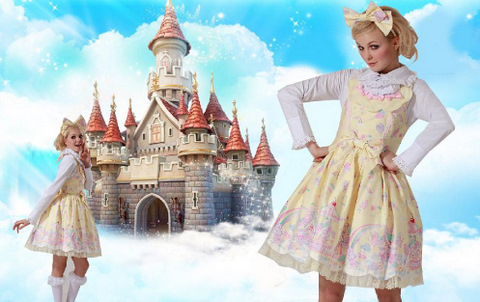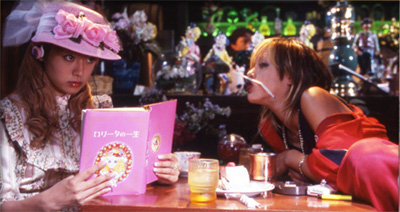The one thing assured to start a heated battle in the Lolita community is the topic of replicas. People have debated the merits endlessly, but the part that has been forgotten in all of this discussion is one simple thing:
The truth.
I would love to live in a perfect world where the creative minds that dream up the beautiful things I love retained direct and complete control over their works forever, profiting handsomely every time their works were reproduced or sold.
That would be great, wouldn’t it?
However, that is simply not the case. In the world of Lolita- and the wider world in general- the designers who toil over those lovely prints don’t actually retain the copyright to their works. The company they produce the prints for does.
Hence the brand name liberally sprinkled over everything. And the copyright marks stating the copyright being attributable to the brand.
The reality is that the designers are either working on salary, or on one-time commission. They don't retain the copyrights, and they sure don’t get per-unit royalties, except in the case of named collaborations (possibly).
So, all of those people who throw around much butthurt about “Art Theft” (Yes, I went there) and call anyone who wears a replica Enemy of Art...are wrong.
Dead wrong. At best, you could call them Enemy of Corporate Profit.
If artists are getting a raw deal, it is because of the exploitive nature of the relationship between labor and capital (OMG! Is this about to veer into Socialist rhetoric? Yes. Yes it is.). Capital sets the terms of employment, and those terms are generally unfavorable to labor. In the world of Lolita print design, what that means is that in most cases, that 4,000th re-release of Holy Lantern isn’t actually directly enriching the artist who drew the design. It is enriching Angelic Pretty- and ONLY Angelic Pretty. We can sit and argue about the “goodness” or “badness” of AP as a company (or any of the other brands, for that matter), but please understand, the company and the company alone profits from print releases on a per-unit basis.
If anyone in Lolita is an Enemy of Art, paradoxically, it is the brands themselves.
What producing a replica DOES do is infringe on the corporation’s copyright. That is against international copyright law, which incidentally, IS enforceable. Granted, it is tough to enforce on producers based in China directly, as China is notoriously lax on enforcement of copyrights, but it can be done. It is done. Many companies that own valuable copyrights go to great lengths to enforce theirs. Many producers of highly sought-after brands build in protection against counterfeits directly into their wares. They are serious about protecting their intellectual property. They are also serious about protecting their customers from unwittingly buying fakes.
What do the brands do to protect their intellectual property? What do they do to protect the buying public? Very little, apparently. AP has a notice on their website saying, “Replicas are bad.” As far as I know, that is the extent of their efforts.
Apparently, the “aggrieved parties” in this copyright infringement aren’t too concerned about the issue. If they were, there is plenty they could do- starting with larger releases in a range of sizes, easier online transactions for international buyers, and multiple price points for their products.
For the most part, they do none of the above.
The brands have a right to run their companies as they please. I am not against capitalism per se, and I don’t begrudge them profits. I hope they make money, and continue to make beautiful dresses. But for the most part, NONE of the purchases I make in Lolita support the brands directly.
First off, most of my brand purchases are second-hand. I’ve only ever bought directly from Metamorphose. My hat is off to them, because they actually made it practical to do so- they make dresses in sizes I can wear, at prices I can afford, and they put them on a website that is easy to navigate, and they ship directly to me at a reasonable rate. So, they get my money. For the other brands, I go to second-hand shops, buy from other members of the community, or buy on online auctions. They never see a direct cent from me. I’m sure the same is true for many- if not most- Lolitas internationally.
Secondly, I buy Bodyline, indie and taobao a lot, too. The prices are good, and the size range variable. Buying direct from some of these sources can still be a pain, but the prices make it worth the bother.
And yes, I do buy replicas. I mostly buy them secondhand, too- so no direct support of replica makers- though I did buy one from an Ebay shop that was probably run buy a Chinese manufacturer. They were print replicas, and I do not feel a bit bad.
I buy dresses for me. Not for social impact. Because true story- you don’t control social impact. See: Tom’s Shoes. You can walk around all holier-than-thou, decked out in brand, but the truth is a lot of what you are wearing is made in the SAME sweatshops in China the replicas come from. Or from the Japanese equivalents where old Auntie-samas are bent over their machines in questionable conditions, making bottom-dollar for their work. And still,at the end of the day, the artists aren’t getting the pay or recognition they deserve, and the brands themselves liberally “borrow” inspiration from other sources. There ARE problems in Loliland, but they are not problems you cause by buying replicas, or solve by NOT buying them.
If I’m going to worry about impact, I’m honestly a lot more worried about the impact rigid, dogmatic thinking about class and size and privilege have on the people who wear Lolita. How DARE anyone say that someone doesn’t “deserve” to wear a cute print they love because of the size of their body or their wallet? If you want to paint anyone in Lolita as a villain, and anyone as a victim, I accuse the replica-shamers as villains, and that makes replica wearers the true victims.
It is fine to decide you don’t want to wear replicas. It is also fine to call out replica-production for what it is- an infringement on corporate copyrights. But don’t hold yourself as superior to other people if you turn around and shame them for wearing replicas. Especially don’t think you are blame-free if you are one of those supercilious hair-splitters who unironically wear Antaina or Bodyline shoes, or carry Loris purses, or buy dress “design replicas” because you can’t “copyright a cut of fabric”. How can one artist (print designer) be worthy of your protection, but another (shoe/purse designer) isn’t?
No, if you engage in the above behaviors, you aren’t “protecting” art or artists. You aren’t standing up for the downtrodden. You are doing the downtrodding.
You are a hypocrite. You should be ashamed of that.
People are more important than profits. Hands-down. Let the companies safeguard their profits. Let Lolita communities safeguard Lolitas.























